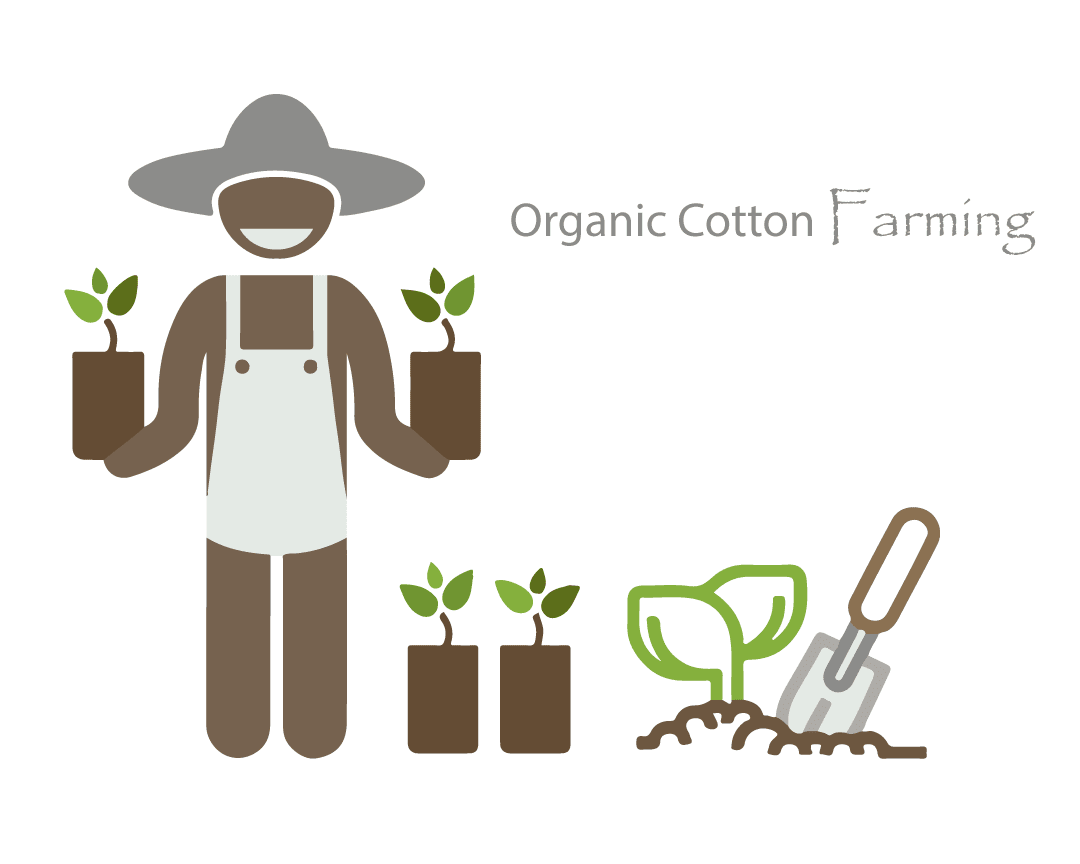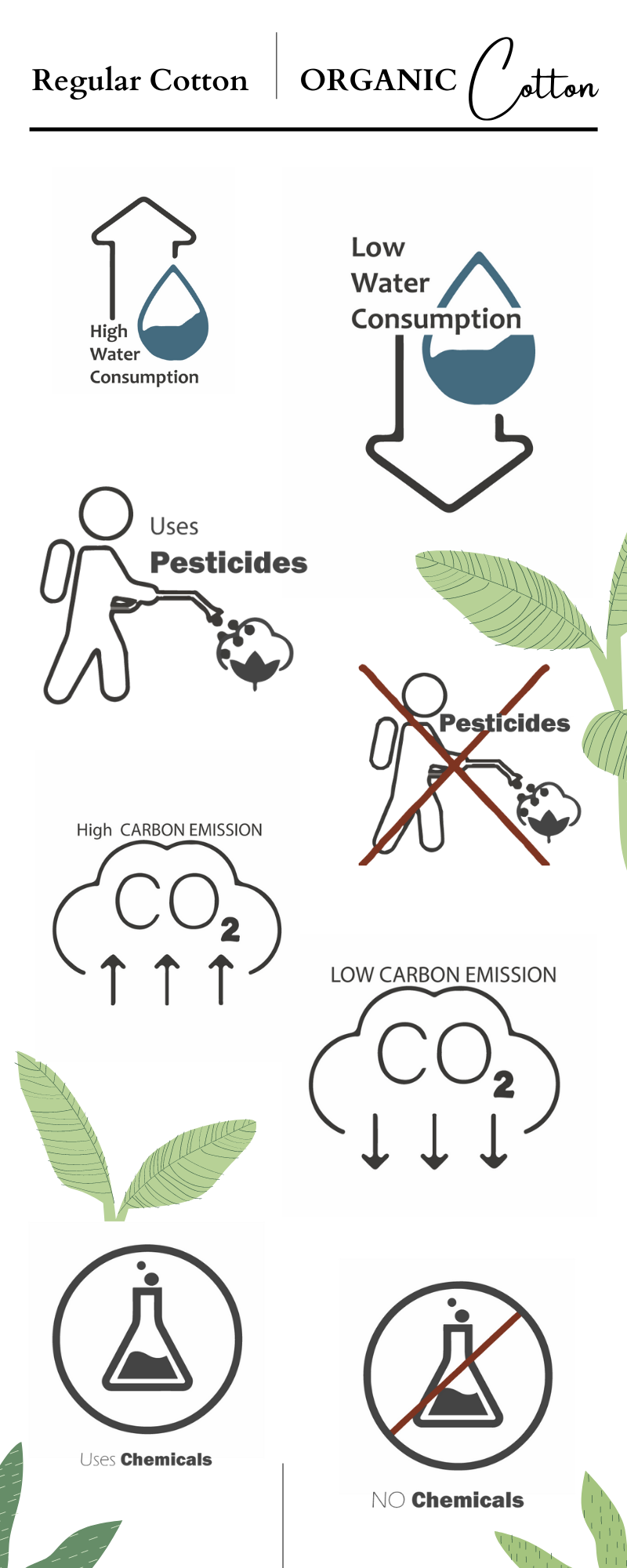With growing concerns regarding climate change, global warming and the numerous health risks associated with chemicals, organic products
Is Cotton Sustainable?
Cotton is a natural fiber, which makes it less destructive to the environment than synthetic fabrics. But is that enough for it to be sustainable?
No.
While natural fabrics are biodegradable for them to be a sustainable commodity, it is important to know how they were cultivated and how were they processed before becoming a garment.
Cotton is the only non-food crop that is cultivated on a very large scale in the world. This means there are millions of acres around the globe cultivating cotton. Hence it has an enormous environmental impact. Cotton seeds are of two types.
- Non-GMO indigenous seeds
- Genetically modified (GMO) seeds
Over 80% of the cotton cultivated worldwide is from hybrid seeds.
Is Cotton from Hybrid Seeds Sustainable?
Hybrid seeds as you can guess from the name are hybrids that are formulated in labs. This means they are genetically modified to get favourable traits from various varieties.
What was the need to develop hybrid seeds?
GMO seeds offer various advantages like-
-
Uniform fibre quality
-
Better adaptability
-
Higher yields
-
Take less time to mature
-
Resistant to certain pests and insects.
While all of this is great, the problem with GMO seeds is that initially all is well but over the years, there are more disadvantages than there are advantages of a hybrid crop.
Let’s take the example of a very popular hybrid Bt Cotton variety-

It was designed to be resistant to bollworms, a major pest that affects cotton. Reduction in bollworms would result in reduction in pests that feed on bollworms. This would help reduce the overall use of pesticides and in turn result in the overall cost reduction.
Theoretically this was perfect, but
1. Eventually other pests that were in check due to bollworms, became dominant and disturbed the crop. 2. More Bt resistant pests started to attack the crop.
3. This led to the increased use of pesticide, which defeated the whole purpose of Bt cotton.
What this conveys is that the design of hybrid seeds targets only one problem without taking into consideration the other aspects of the ecosystem. Nature is not uni-directional. One effect may be the result of multiple causes. But by the time the effects are visible, there is not left much to salvage.
The same has happened with cotton. Farmers are in a loop now, the soil is ruined because of decades of use of chemicals so they cannot go for natural farming and they still need to harvest crops so Bt cotton is still popular.
So what is the solution? Organic Cotton Fabric.
What is Organic Cotton Fabric?
Organic cotton is cultivated from non-GMO seeds. Additionally, the method of organic farming prohibits the use of artificial insecticides, pesticides or chemicals.
The organic cotton crop is mostly rain-fed ( rains are unpredictable now due to climate change so irrigation has become a necessity) and because it has been cultivated for centuries in the climate, it is tolerant to the climate and is resistant to pests as well.
Is organic cotton fabric as beneficial as it seems?
With the increase in climate change and global warming, each step taken by us matters, be it even by transforming our cotton closet into a fabric organic cotton closet.
We are living in a time, where each step will either lead to an immense increase in global warming or will lead to the protection of Mother Earth. So why not make our actions count and take a step by protecting our nature by switching to organic clothing?!
Advantages of Organic Cotton Fabric
- It is practised by environment-friendly methods of farming. Hence it is good for the earth.
- It is a safer option as manufacturers must follow strict standards for their product to be certified as fabric organic cotton.
- The overall production cost is cheaper in the long run as seeds can be saved for the next season.
Also, the cost of chemical pesticides and fertilizers is not present.
- Fabric Organic Cotton is skin-friendly and allergy-proof. There is no chemical retention in organic cotton fabrics because it is produced in chemical-free soil.
- When organic cotton is bought, it benefits the consumers as well as supports farmers’ livelihoods and gives them a chance to stay away from harmful chemicals.
- Certified Organic Cotton Fabrics ensure that there are fair working conditions for everyone involved in the supply chain from the grassroots.
- Organic Cotton Fabrics cause far less pollution than hybrid cotton because they are often grown, harvested as well as processed with natural and organic substances.
- Organic cotton, when compared to regular cotton, brings a radical positive change to the environment. To manufacture, just one t-shirt, regular cotton uses 16% of the world’s insecticides, 7% pesticides and 2,700 litres of water, when compared to this, organic cotton uses 62% less energy than regular Cotton.
Why is Organic Cotton Farming not Popular?

You would think that if organic cotton fabrics have so many benefits it would be super popular. Sadly, that’s not the case. While organic cotton farming is beneficial to everyone involved including humans and the earth, it is difficult to practice because-
- It can give great results in a soil that is full of organic matter and life. Currently, there is hardly such soil available. Chemicals in the soil have become abundant due to which organic farming is nearly impossible.
- Lower yields as compared to hybrid cotton
- Labour intensive
- No use of chemicals makes it harder for farmers who are dependent on insecticides and pesticides for a good harvest.
- Unlike Bt cotton, non-uniform fibres are obtained from organic cotton.
- Also, farmers have concern that there is not enough market for organic cotton. Growing organic cotton is a labor-intensive job and if the remuneration is not sufficient it is difficult for farmers to keep up.
- The cost of the finished product, i.e. organic cotton fabric is higher than regular cotton, which makes it difficult for everyone to afford it.
And most importantly
If at all someone brave enough takes up the task to get back to methods that have proved effective over thousands of years, i.e. the use of indigenous seeds, the path is a difficult one.
Lower yields are not acceptable because the demand for cotton is very high. And with the continuous use of chemicals, the soil quality is rarely good to grow organic crops. While soil quality can improve over time, practising organic farming over severely damaged soil is bound to fail without first enriching the soil. Farmers in developing countries like ours cannot afford to invest that much time due to economic as well as social reasons.
Why do we need to shift to Organic Cotton Fabric?
- Research over the years has linked chemical fertilizers and pesticides to many lethal diseases lung cancer, skin cancer and many more. There are insecticides that contain chemicals that disrupt the working of the nervous system of insects. While the target was insects, the chemical also has adverse effects on the nervous systems of humans as well.
- Worldwide over 90% of the deaths related to pesticides occur in developing countries. And India is one of the largest cultivators of cotton.
- Large amounts of water are used to irrigate the cotton crop. And the water that seeps into the ground, pollutes the groundwater as well which is often used for drinking purposes.
- Spraying of pesticides is often done without any protective gear. This is harmful to the health of farmers. Sometimes children are also involved in the farming and harvesting of cotton which causes various infections and diseases. Over-exposure can also lead to death.
- While all of the above reasons are driving us towards organic cotton fabric, it is consumer awareness that is driving fashion brands to integrate more sustainable fabrics.
Even though hybrid cotton continues to be cultivated widely, soil under organic cotton cultivation is also increasing which is a good sign for the earth.
Now, with global warming and climate crisis looming over, it is slowly being realized that organic cotton production is a much cleaner and greener alternative.
How to know if it is the organic cotton fabric?
It is impossible to know if the garment is made from organic cotton simply by touch and feel. Hence as consumers, we have to rely on what brands disclose about their fabrics.
There are always labels that are honest about what goes into their products and there are some that are not as honest as we would like them to be. So labels on clothes do not completely reveal what kind of cotton was used or if the product is 100% cotton. But there are international standards that help consumers choose the right products. We just need to be aware of how to find those brands.
Organizations like GOTS ( Global Organic Textile Standard) have a thorough the procedure to certify a fabric as organic cotton. While the growing and harvesting process are definitely important, this organization also takes into account the working conditions of employees. Organizations like these attempt to get a fair price for fabrics for the manufacturers while keeping in mind that consumers get genuine products.
All in all, organic cotton fabrics are definitely better than regular cotton. The benefits are drawn by you as a consumer and also by the farmers and the earth as well. And I think with the growing demand of organic fabrics, the prices will also become competitive and hopefully make organic fabrics more readily available.
If natural fabrics are your thing then I think you should look no further. Suvetah is GOTS certified sustainable fabric manufacturer of Organic Cotton Fabric, Linen Fabric and Hemp Fabric. We have a variety of other natural fabrics as well and for anyone looking to get even more sustainable, we even offer services of naturally dyeing fabrics!



 Inspite of all the difficulties that farmers and consumers face it is still beneficial to grow as well as adopt organic cotton. Previously organic cotton was cultivated extensively. It was not until 1995-97 that Bt cotton was introduced in India. The higher yields and pest resistant qualities were marketed and governments around the world accepted these hybrid varieties.
Inspite of all the difficulties that farmers and consumers face it is still beneficial to grow as well as adopt organic cotton. Previously organic cotton was cultivated extensively. It was not until 1995-97 that Bt cotton was introduced in India. The higher yields and pest resistant qualities were marketed and governments around the world accepted these hybrid varieties.